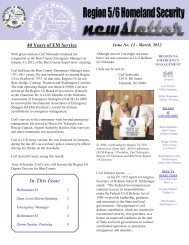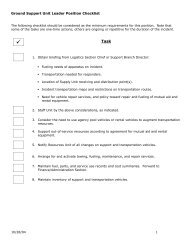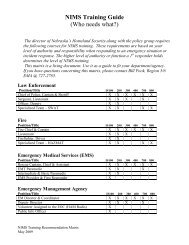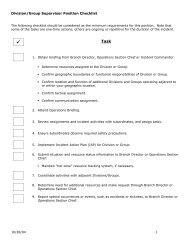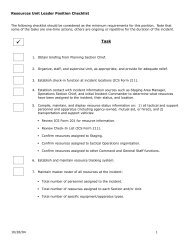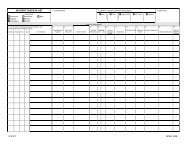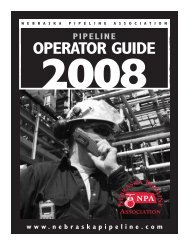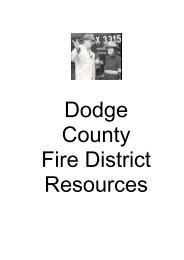FEMA Emergency Preparedness Checklist - Region 5/6
FEMA Emergency Preparedness Checklist - Region 5/6
FEMA Emergency Preparedness Checklist - Region 5/6
Create successful ePaper yourself
Turn your PDF publications into a flip-book with our unique Google optimized e-Paper software.
TORNADO • FLASH FLOOD • EARTHQUAKE • WINTER STORM • HURRICANE • FIRE • HAZARDOUS MATERIALS SPILL<br />
✓<br />
<strong>Emergency</strong> <strong>Preparedness</strong><br />
<strong>Checklist</strong><br />
Federal <strong>Emergency</strong><br />
Management Agency<br />
T<br />
he next time disaster<br />
strikes, you may not<br />
have much time to<br />
act. Prepare now for<br />
a sudden emergency.<br />
Learn how to protect yourself<br />
and cope with disaster<br />
by planning ahead. This<br />
checklist will help you get<br />
started. Discuss these<br />
ideas with your family, then<br />
prepare an emergency plan.<br />
Post the plan where everyone<br />
will see it—on the<br />
refrigerator or bulletin<br />
board.<br />
For additional information<br />
about how to prepare for<br />
hazards in your community,<br />
contact your local<br />
emergency management<br />
or civil defense office<br />
and American Red Cross<br />
chapter.<br />
<strong>Emergency</strong> <strong>Checklist</strong><br />
Call Your <strong>Emergency</strong><br />
Management Office<br />
or American Red Cross<br />
Chapter<br />
❏ Find out which disasters could<br />
occur in your area.<br />
❏ Ask how to prepare for each disaster.<br />
❏ Ask how you would be warned of<br />
an emergency.<br />
❏ Learn your community’s<br />
evacuation routes.<br />
❏ Ask about special assistance for<br />
elderly or disabled persons.<br />
Also...<br />
❏ Ask your workplace about<br />
emergency plans.<br />
❏ Learn about emergency plans for<br />
your children’s school or day care<br />
center.<br />
Create an <strong>Emergency</strong><br />
Plan<br />
❏ Meet with household members to<br />
discuss the dangers of fire, severe<br />
weather, earthquakes and other<br />
emergencies. Explain how to<br />
respond to each.<br />
❏ Find the safe spots in your home<br />
for each type of disaster.<br />
❏ Discuss what to do about power<br />
outages and personal injuries.<br />
❏ Draw a floor plan of your home.<br />
Mark two escape routes from each<br />
room.<br />
❏ Show family members how to turn<br />
off the water, gas and electricity at<br />
main switches when necessary.<br />
❏ Post emergency telephone numbers<br />
near telephones.<br />
❏ Teach children how and when to<br />
call 911, police and fire.<br />
❏ Instruct household members to turn<br />
on the radio for emergency information.<br />
❏ Pick one out-of-state and one local<br />
friend or relative for family members<br />
to call if separated during a disaster<br />
(it is often easier to call out-of-state<br />
than within the affected area).<br />
❏ Teach children your out-of-state<br />
contact’s phone numbers.<br />
❏ Pick two emergency meeting places.<br />
1) A place near your home in case<br />
of a fire.<br />
2) A place outside your neighborhood<br />
in case you cannot return<br />
home after a disaster.<br />
❏ Take a basic first aid and CPR class.<br />
❏ Keep family records in a water and<br />
fire-proof container.<br />
Prepare a Disaster<br />
Supplies Kit<br />
Assemble supplies you might need in an<br />
evacuation. Store them in an easy-to-carry<br />
container such as a backpack or duffle bag.<br />
Include:<br />
❏ A supply of water (one gallon per<br />
person per day). Store water in<br />
sealed, unbreakable containers.<br />
Identify the storage date and replace<br />
every six months.<br />
❏ A supply of non-perishable packaged<br />
or canned food and a non-electric<br />
can opener.<br />
❏ A change of clothing, rain gear and<br />
sturdy shoes.<br />
❏ Blankets or sleeping bags.<br />
❏ A first aid kit and prescription<br />
medications.<br />
❏ An extra pair of glasses.<br />
❏ A battery-powered radio, flashlight<br />
and plenty of extra batteries.<br />
❏ Credit cards and cash.<br />
❏ An extra set of car keys.<br />
❏ A list of family physicians.<br />
❏ A list of important family information;<br />
the style and serial number of<br />
medical devices such as pacemakers.<br />
❏ Special items for infants, elderly or<br />
disabled family members.
<strong>Emergency</strong> Plan<br />
Out-of-State Contact<br />
Name<br />
City<br />
Telephone (Day)<br />
Local Contact<br />
Name<br />
Telephone (Day)<br />
Nearest Relative<br />
Name<br />
City<br />
Telephone (Day)<br />
Family Work Numbers<br />
Father<br />
Other<br />
(Evening)<br />
(Evening)<br />
(Evening)<br />
Mother<br />
Escape Plan<br />
n a fire or other emergency, you<br />
I<br />
may need to evacuate your house,<br />
apartment or mobile home on a<br />
moment’s notice. You should be<br />
ready to get out fast.<br />
Develop an escape plan by drawing a floor<br />
plan of your residence. Using a black or blue<br />
pen, show the location of doors, windows,<br />
stairways, and large furniture. Indicate the<br />
location of emergency supplies (Disaster<br />
Supplies Kit), fire extinguishers, smoke<br />
detectors, collapsible ladders, first aid kits<br />
and utility shut off points. Next, use a<br />
colored pen to draw a broken line charting<br />
at least two escape routes from each room.<br />
Finally, mark a place outside of the home<br />
where household members should meet in<br />
case of fire.<br />
Be sure to include important points outside<br />
such as garages, patios, stairways,<br />
elevators, driveways and porches. If your<br />
home has more than two floors, use an<br />
additional sheet of paper. Practice<br />
emergency evacuation drills with all<br />
household members at least two times<br />
each year.<br />
<strong>Emergency</strong> Telephone Numbers<br />
In a life threatening emergency, dial 911 or the local emergency medical services system number<br />
Police Department<br />
Fire Department<br />
Example:<br />
Floor one<br />
Hospital<br />
Family Physicians<br />
Name<br />
Name<br />
Name<br />
Telephone<br />
Telephone<br />
Telephone<br />
Reunion Locations<br />
1. Right outside your home<br />
2. Away from the neighborhood, in case you cannot return home<br />
Address<br />
Telephone<br />
Route to try first
Floor Plan<br />
Floor One<br />
Floor Two<br />
Normal Exit Route<br />
<strong>Emergency</strong> Exit Routes<br />
Fire Extinguisher<br />
Smoke Detectors<br />
Disaster Supplies Kit<br />
Doors<br />
Collapsible Ladder<br />
Reunion Location (Outside)<br />
Stairways<br />
Utility Shut Off<br />
Windows<br />
First Aid Kit
Home Hazard Hunt<br />
In a disaster, ordinary items in the home<br />
can cause injury and damage. Anything<br />
that can move, fall, break or cause a fire<br />
is a potential hazard.<br />
❏ Repair defective electrical wiring<br />
and leaky gas connections.<br />
❏ Fasten shelves securely and brace<br />
overhead light fixtures.<br />
❏ Place large, heavy objects on lower<br />
shelves.<br />
❏ Hang pictures and mirrors away<br />
from beds.<br />
❏ Strap water heater to wall studs.<br />
❏ Repair cracks in ceilings or<br />
foundations.<br />
❏ Store weed killers, pesticides and<br />
flammable products away from<br />
heat sources.<br />
❏ Place oily polishing rags or waste in<br />
covered metal cans.<br />
❏ Clean and repair chimneys, flue<br />
pipes, vent connectors and gas vents.<br />
If You Need to Evacuate<br />
❏ Listen to a battery powered radio for<br />
the location of emergency shelters.<br />
Follow instructions of local officials.<br />
❏ Wear protective clothing and<br />
sturdy shoes.<br />
❏ Take your Disaster Supplies Kit.<br />
❏ Lock your house.<br />
❏ Use travel routes specified by local<br />
officials.<br />
If you are sure you have time ...<br />
❏ Shut off water, gas and electricity, if<br />
instructed to do so.<br />
❏ Let others know when you left and<br />
where you are going.<br />
❏ Make arrangements for pets. Animals<br />
may not be allowed in public shelters.<br />
Prepare an<br />
<strong>Emergency</strong> Car Kit<br />
Include:<br />
❏ Battery powered radio, flashlight and<br />
extra batteries<br />
❏ Blanket<br />
❏ Booster cables<br />
❏ Fire extinguisher (5 lb., A-B-C type)<br />
❏ First aid kit and manual<br />
❏ Bottled water and non-perishable high<br />
energy foods such as granola bars,<br />
raisins and peanut butter<br />
❏ Maps, Shovel, Flares<br />
❏ Tire repair kit and pump<br />
Fire Safety<br />
❏ Plan two escape routes out of each<br />
room.<br />
❏ Practice fire drills at least twice a year.<br />
❏ Teach family members to stay low to<br />
the ground when escaping from a fire.<br />
❏ Teach family members never to open<br />
doors that are hot. In a fire, feel the<br />
bottom of the door with the palm of<br />
your hand. If it is hot, do not open<br />
the door. Find another way out.<br />
❏ Install smoke detectors on every level<br />
ofyour home. Clean and test them<br />
at least once a month. Change<br />
batteries at least once a year.<br />
❏ Keep a whistle in each bedroom to<br />
awaken household in case of fire.<br />
❏ Check electrical outlets. Do not<br />
overload outlets.<br />
❏ Purchase and learn how to use a fire<br />
extinguisher (5 lb., A-B-C type).<br />
❏ Have a collapsible ladder on each<br />
upper floor of your house.<br />
❏ Consider installing home sprinklers.<br />
The Federal <strong>Emergency</strong> Management Agency’s Community and Family <strong>Preparedness</strong> Program and the American Red Cross Community<br />
Disaster Education Program are nationwide efforts to help people prepare for disasters of all types. For more information, please<br />
contact your local emergency management office and American Red Cross chapter. This brochure and other preparedness materials<br />
are available by calling <strong>FEMA</strong> at 1-800-480-2520, or writing: <strong>FEMA</strong>, P.O. Box 2012, Jessup, MD 20794-2012.<br />
Publications are also available on the World Wide Web at:<br />
<strong>FEMA</strong>’s Web site: http://www.fema.gov<br />
American Red Cross Web site: http://www.redcross.org Your Local Contact is:<br />
L-154<br />
ARC 4471<br />
Aug. 1993




